Khajuraho Temples – celebration of life and love & not just eroticism
The guide kept referring to a certain section of the sculptures in Sun temple Konark as Khajuraho . I and my friends couldn’t stop smiling. This was sometime in 2009, and it made me think that why is this temple and its history only associated with eroticism. I had heard of various stories about Khajuraho and I always thought that there was more to this temple.
I visited Khajuraho in 2010 and explored this place on foot and on bicycle. The first thing that struck me was that perhaps only 10% of the carvings (though they are quite in your face) on the temple walls were around eroticism. There were a lot of carvings explaining the day to day life of the Kings, Queens, farmers, musicians, soldiers, teachers, potters and more.
Interestingly Khajuraho temples have gained popularity as the erotic temples of India and rest everything is nicely neglected. Pareto in practice I say , where 10% of the art form gets 100% of attention and fame (or defame).
History of the Khajuraho temples
Khajuraho temples were built by the Chandella rulers between AD 900 and 1130. It is believed that every Chandella ruler has built at least one temple in his lifetime. Perhaps the different temples in the Khajuraho complex were not constructed by any single Chandella ruler, keeping up with the tradition of building temples. The Khajuraho temples have idols of Vishnu, Shiva , Devi, and Jain Tirthankaras. These temples were reported for the first time by Abu Rihan al Biruni in AD 1022 and the Arab traveller Ibn Battuta in AD 1335.
How did the temple get its name?
The Chandella Kings had fortified Khajuraho by building a boundary wall with around eight for entry – exit. It is said that each gate had two date palm trees from which the place gets its name. The temples were called “Khajura-vahika”. Khajura’ means ‘date’ and ‘vahika’ means ‘bearing’ in Hindi. Khajuraho is also known as “Jejakbhukti”.
There is more to Khajuraho than just the Erotic Sculptures
As per the Archaeological Survey of India book on Khajuraho, the sculptures can be grouped into five broad categories.
- The first category are the cult images and they are built exactly as prescribed in the Shilpashastra (manual on craftsmanship). Some of these have been carved as the Teerthankaras, similar to the ones in the Jain museum.
- The second category of sculptures are the ones which represent attendants, the Guardian deities, the Gandharvas, the Shiva ganas, etc
- The third category is that of Apsaras (celestial nymph), carved as very attractive women indulged in various activities. They are portrayed as dancing, painting, holding a parrot, dressing up etc
- The fourth category is about the daily life of a common man. Warriors, dancers, scenes of musicians playing in a royal court, a teacher with his student , horses , elephants .
- The fifth category is the Erotic carvings, which have made the temple so popular that everyone tends to forget about the other four. The carvings are in your face and depict people indulging in sexual activity, orgies and more.
Temples of Khajuraho
As per historical records the Khajuraho temple site had 85 temples by the 12th century, of which, only 25 temples have survived. The following are some of the key temples of Khajuraho. The Khajuraho group of temples were dedicated Hinduism and Jainism. It is also a symbol of respect for diverse religious views. The surviving temples are dedicated to Shiva, Vishnu , Ganesha, Shakti, Sun god, and Jain Tirthankars. Here are some of the key temples in Khajuraho
a) Kandariya Mahadev Temple: Dedicated to Lord Shiva this temple towers above almost all the other temples in Khajuraho. It is said that it represents Mt Kailash and King Vidhyadhara had built it after a winning a crucial battle
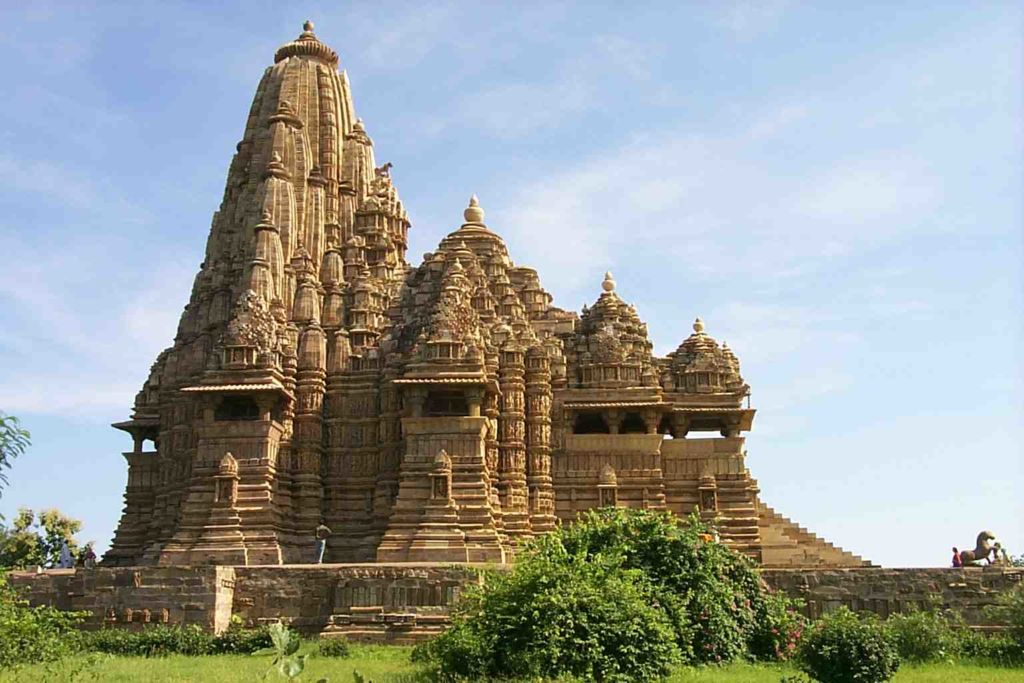
b) Lakshmi Temple: This temple is dedicated to Lord Vishnu and has an intricately carved monolith of Varaha (Boar, a reincarnation of Vishnu) built of sandstone. The sculpture of Garuda Vishnu’s vehicle ) is no longer there.
c) Lakshmana Temple : This is also dedicated to Lord Vishnu and has the Vaikunta image of Vishnu with three different faces – that of a lion, boar and a human. The carvings here depict social and cultural lives of the Chandela Kings.

d) Chausath Yogini temple: This is built in an open sanctuary and all the cells are empty. There is no idol of Goddess Shakti. But it is believed that the Chausath Yogini temple is about Shakti cult and Tantric cult .
e) Chitragupta Temple : It is dedicated to Surya, the Sun God
f) Jain Temples : These temples are dedicated to the Jain Tirthankaras Adinatha, Parshwanatha and Shantinatha
g) Dulhadeo temple : Here Shiva is a bridegroom and this temple is dedicated to weddings, fertility rites and cults .
h) Chaturbhuj Temple: This is again dedicated to Lord Vishnu and houses a Vishnu idol with four arms.
j) Jagadami Temple: This temple is dedicated to goddess Jagadambika ( Parvati), and has a huge image of the goddess inside the sanctum.
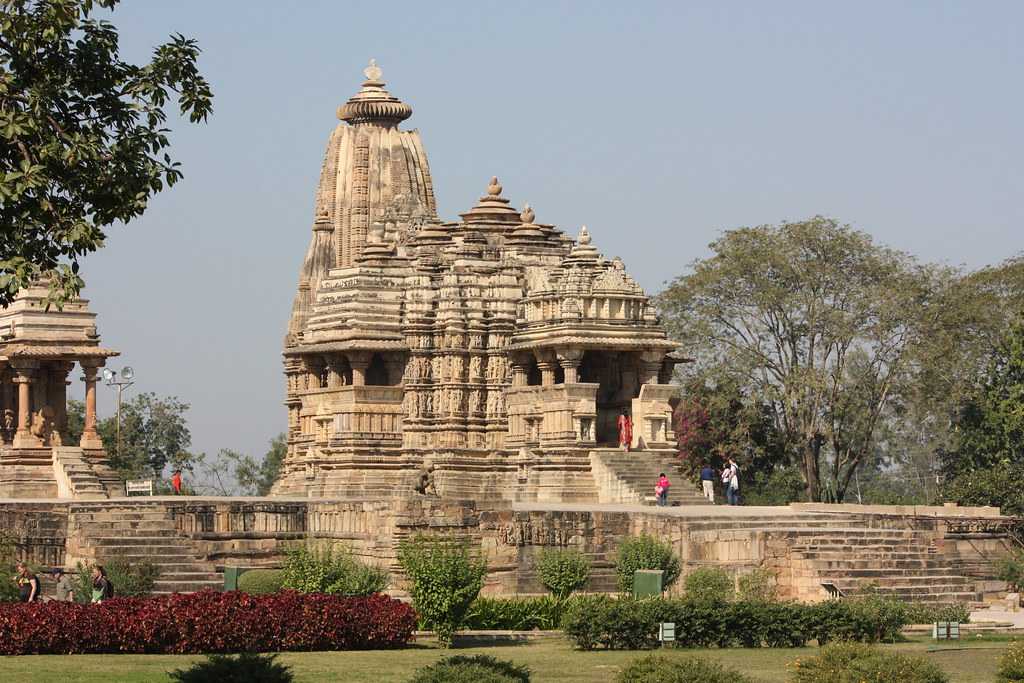
Khajuraho temple Architecture
Khajuraho temples follow a common pattern. Almost all the temples are east facing. The entrance porch has two elephant trunk carvings. These temples have been built with sandstone, with varying shades of pink and pale yellow. Each temple has an entrance, a hall, a vestibule and a sanctum. Inside the temple there are rooms that are inter-connected and placed on an East/West line and constructed with spiral superstructures. There are four smaller temples surrounding the main temple located at the four corners.
So what is the story behind the eroticism in Khajuraho ?
The temple walls and pillars have intricate carvings of sexual and erotic acts as if they are trying to talk to us about worldly pleasures. The question that comes to one’s mind is why someone would want to depict sexuality so openly on the exteriors of a large temple complex . Sure India is the land of Kamasutra, but why choose a temple to promote it?
There are many stories behind the whole thought process. I had picked up these stories from the versions shared by the tour guides, the audio guide commentary and also what is narrated in the light and sound show at the Khajuraho temple complex. All of them are different and one is not sure, which one to believe, but then isn’t that the most interesting part of the travel-fuelling your imagination!
Descendants of Moon (Chandrama)
This is the most popular story or myth amongst the locals. A young and beautiful girl called Hemavathi was bathing in the night under moonlight. The moon god got attracted and seduced her. She became pregnant and ran into the forests, where she gave birth to a son called Chandravarman. She raised her son in the forest who grew up and established the Chandela dynasty. Apparently, the moon had promised Hemavathi that their son would one day become a King.
It is believed that Chandravarman was influenced by his mother’s story of love and sacrifice. And hence he built temples with sculptures depicting human passion and love. Moon god is known for romance and hence it is not surprising that his son built the temples that talk about love and eroticism.
Cycle of life in Hinduism
One version states that it is a depiction of the Hindu philosophy of Dharma, Artha, Kama , Moksha . One can attain nirvana, once you are done with all your wordly pleasures and if you look at all the carvings it is about day to day life, teacher with students etc. The other important fact is that all these carvings are a part of the exterior and inside the temple is only about deities. So maybe it is the manifestation of the thought that human being can be one with the god once he/she has overcome the worldly pleasures. Sounds logical , isn’t it ? Wait, there are more interpretations …
Auspicious symbol
In India, Dampatya (Marriage) is considered as Mangalya (auspicious) . Shiva and Shakti are married and always in a union. The carvings of mating and lovemaking along with other depictions was probably aimed at promoting “Dampatya Jeevan” (marital life) and explaining its importance to the people.
As per Brihat Samhita, mithunas (sexual union), creepers and erotic sculptures were meant to be carved on the temple door to bring good luck. This was linked to the idea of preparing young boys who have finished their “brahmacharya” for the worldly desires and learn about them before they enter the Grihastha (householder) ashram.
Coexistence of love, lust and Nirvana
If you look at the erotic sculptures, a lot of them depict people mating and meditating at the same time. Some of them are in the Sheershasana and some are with their eyes closed. May be it is a way to say that Moksha (salvation) can also be attained while leading a normal life of a householder. This is also in line with the Hindu philosophy of Purusha (spirit & pure consciousness) and Prakriti (Nature and which gives shape or forms) always being united. It is also possible that Buddhism was spreading fast in India and the King didn’t want people to align themselves with renunciation and salvation. These temples were created to make people talk about love and worldly pleasures.
Procreation for population
One of the legends states that the kingdom had lost a lot of its soldiers in the battle and the population declined. The King wanted people to talk openly about love, make love and procreate and hence dedicated the exteriors of the temple with these erotic carvings . By the way, I had heard almost a similar version at Konark temple also.
Tantric Cult
This belief originates from the fact that there is Chausath Yogini temple at the complex. This is believed to be the oldest temple in Khajuraho. This temple is different from the other temples at Khajuraho and depicts a style different from the Chandela style of architecture. Besides, there are sculptures of Aghoris and the Kapaalikas (lady tantric) holding a skull in their hand.
People believe that the various love making postures are basically depicting awakening of Kundalini (tapping the human energy to attain bliss and sipirituality). Tantrics used sex to awaken this energy. The Chandela king who had interest in tantrism is said to have involved in these practices and there are sculptures which loosely point to this fact.
Celebration of womanhood
These temples can also be called as one for the celebration of womanhood. There are a lot of sculptures of very beautiful women adorning heavy jewellery. They can be seen engaging in differ activities like wearing make-up, washing their hair, playing games and knotting and unknotting their hair girdles. And love making is just another part of their daily life.
While there are multiple stories around the eroticism displayed on the temple walls, many scholars believe that erotic arts are part of the Hindu tradition. Kama (lust) is an essential and proper part of human life as per Hinduism , and its symbolic or explicit display is common in Hindu temples. Not to forget Kamasutra book was written in India !
Decline of Khajuraho temples
After the fall of the Chandella dynasty and the rise of the Mughal Empire from 13th century onwards, many temples were destroyed and many more were left to rot. But a lot of temples survived, either due to Khajuraho being away from the bigger cities or because of the forest cover. However, because they were neglected for many centuries and this led to the growth of forests around the temple.
It was later re-discovered by British engineer T S Burt. At that time it was found that many yogis Hindus came to Khajuraho for pilgrimage. Khajuraho became a UNESCO heritage site in 1986.
Khajuraho – eroticism overtaking the larger picture
These temples are testimony to the fact that Indian culture was very open and practical about life. Unlike the current time where, any such discussion would attract strange looks, the Kings then had perhaps built these to create education.
Our guide was initially very hesitant to talk, however, after some time he was fine. He was knowledgeable and was able to share different perspectives of the locals and tourists towards these temples. The sense of humour of these tour guides whether in Konark or in Khajuraho can be amazing. There is a prominent sculpture of a lady taking out a thorn from her feet. Our guide was very confident that this is the inspiration behind the famous Bollywood song “ Kaanta laga”.
The trip to Khajuraho answered my initial question of why a part of Konark was being called Khajuraho. But the bigger takeout for me was that these temples are about the daily lives of people those days and sex was a small part of it and it should be looked at like that.
How to reach Khajuraho?
Khajuraho has a domestic airport, which is connected to some of the Indian cities like New Delhi, Mumbai, Varanasi, Allahabad and Bhopal.
Though Khajuraho railway station is connected with few cities, but there railway stations within 70 to 100 kms which make it accessible from different cities.
It is also very convenient to drive in Madhya Pradesh and reach Khajuraho
Best time to go to Khajuraho ?
October to March is the best time to visit Khajuraho. July to September is also good with the rain treated look of the town. April , May , June is very hot and should be avoided
For more such spiritual experiences in India, you could take a look at the article on India – The Spiritual Abode .
In case you are keen on traveling to Khajuraho and Madhya Pradesh, you could take a look at the itinerary of Madhya Pradesh and explore the Khajuraho temples.
In case culture is of interest, check out the places of cultural interest in India.
India is not just about spirituality. There are many more facets to this ancient land – culture, mystery, history, nature, wildlife and so on. Read more about other fascinating places to visit in India .

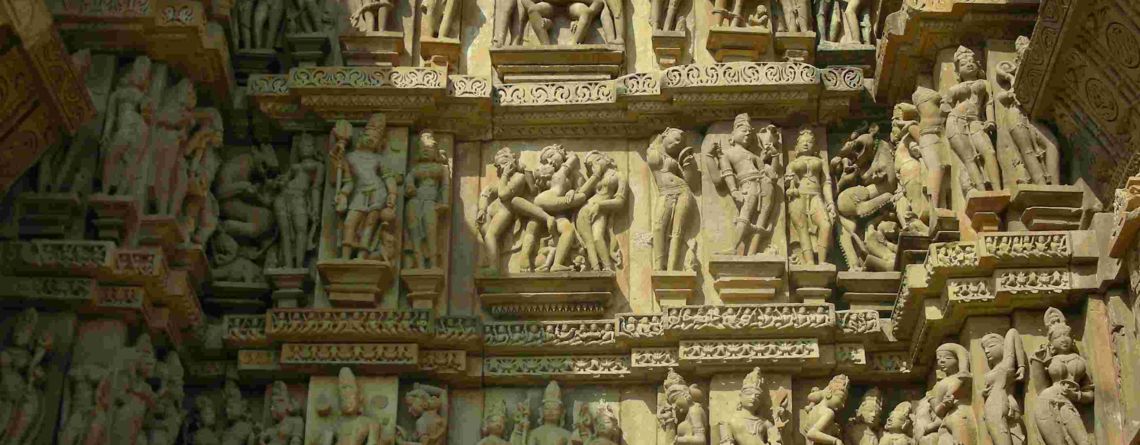
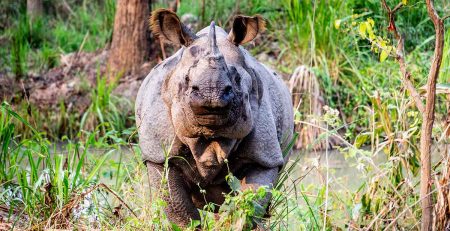

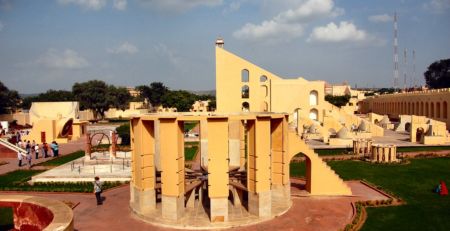

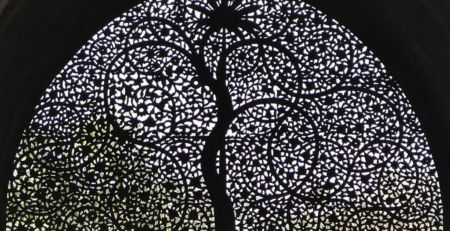
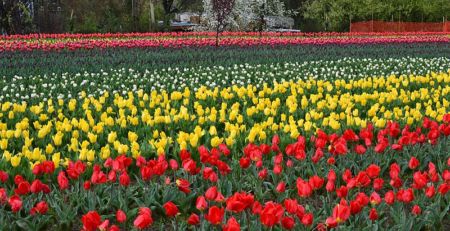
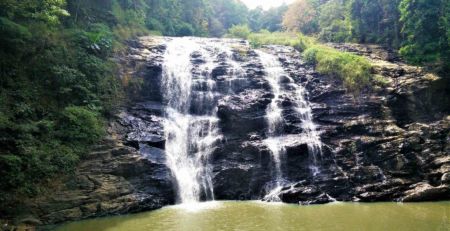
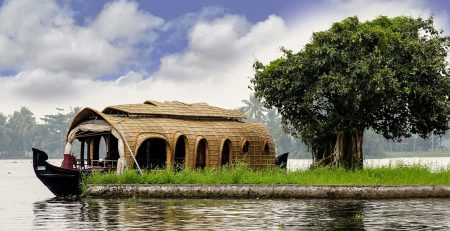
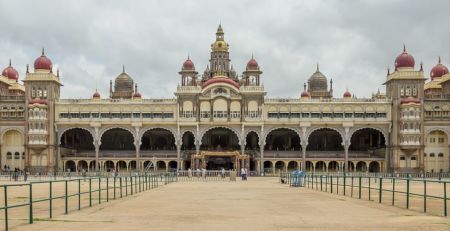

Comments (3)
Hi,
Greetings
I thoroughly enjoyed reading your blog post on art and architecture. I recently visited a similar architectural masterpiece in Bhrihadeeshwarar Temple, Thanjavur , and it’s fascinating how it echoes the principles you mentioned. I found the integration of nature and structural design truly captivating.
Would like to do more cultural trip to experience the Marvelous Architecture of India.
Thank you for sharing your expertise and passion for art and architecture through this blog post
Hi,
Greetings
I thoroughly enjoyed reading your blog post on art and architecture. I recently visited a similar architectural masterpiece in Bhrihadeeshwarar Temple, Thanjavur , and it’s fascinating how it echoes the principles you mentioned. I found the integration of nature and structural design truly captivating.
Would like to do more culture trips to experience the marvelous architecture of India.
Thank you for sharing your expertise and passion for art and architecture through this blog post
Hi.
Thank you for your kind comments. I am glad you found the blog interesting.